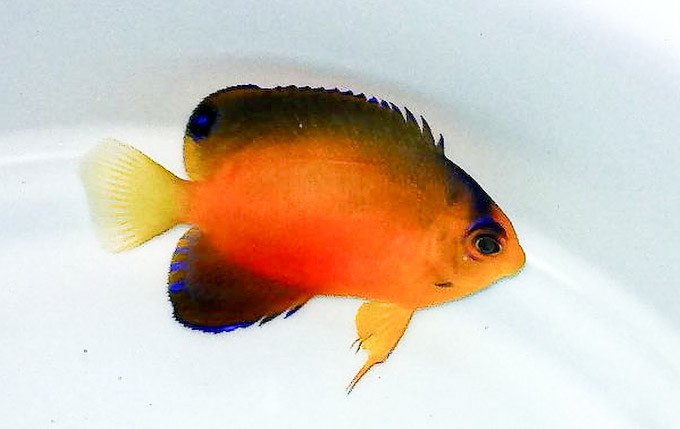Centropyge hybrids are currently the cool kids at the party and have been circulating the industry and internet so widely that you might think it’ll be hard to pull another textbook-defying specimen out of the sea. While super rare hybrids like the tigerpyge angel and the Fisher’s x Potter’s hybrid remain extremely elusive still, some other hybrids such as the Rusty x Flame angels have become commonplace in the hobby.
The super rare hybrid of Centropyge multicolor and C. ferrugata shown above unfortunately belongs to the former, and is currently the second piece caught and photographed, this time by Extreme Corals of Germany. What makes this hybrid so special despite its obvious genetics is the location in which it was caught. Both this hybrid multicolor angelfish and the first specimen were collected in Cebu, Philippines, where C. multicolor supposedly does not occur.
In the same way that C. loriculus (Flame Angelfish) made its way from the Central Pacific to the islands of Philippines, C. multicolor made a jump too and a small population was then established. Waifs are rare but not impossible and such is most likely the case for both C. loriculus and C. multicolor. Using C. loriculus as the “model” of hybridization here, it’s not entirely unbelievable that the now alien population of C. multicolor followed suit. C. loriculus, being present in a much smaller population, is forced to breed with other closely related species in Cebu, in this case, C. ferrugata (Rusty Angelfish).
We can expect the same for our lonely population of C. multicolor, except not quite. You see, while C. loriculus and C. ferrugata are closely related and will readily spawn, C. multicolor is not. This complete lack of relation coupled with the fact that one parent species was a waif from what we believe to be Palau, further decreases the likelihood of this happening. But it did! Hybrids between two unrelated and distant relative of fish within the same genus are rare, but not impossible. Such is also seen with the Fisher’s x Potter’s hybrid.
Embedded somewhere within that thick cloud of scientific jargon we just mentioned was the fact that this was the second piece to be collected. The first piece pictured directly above, brought in by Brian Griffin of Ocean Gallery is the first ever to be documented and photographed. While we strongly believe it is cross between C. multicolor and C. ferrugata, we cannot discount the possibility that it could be a tri-hybrid, of [C. multicolor x (C. loricula x C. ferrugata)]. Since all three parents can be found in Cebu, coupled with the fact that C. loricula and C. ferrugata often hybridize to produce fertile viable hybrid offspring, our little C. multicolor hybrid here could be the lovechild of the False Shepardi hybrid. One thing’s for sure, it is definitely not a hybrid between C. multicolor and C. shepardi, which it was previously erroneously identified as.
Bear in mind that hybrids of C. multicolor are extremely rare and more so with another species that is typically not found in the same range as it. Hybrids with other species however, have not gone unnoticed, and here’s a picture of a specimen of C. multicolor x C. bispinosa that is currently residing in one of the display tanks in BlueHarbor. was taken at a LFS in Kyoto, Japan. The photograph of this super rare multicolor x coral beauty hybrid was taken by angelfish aficionado John Coppolino.






